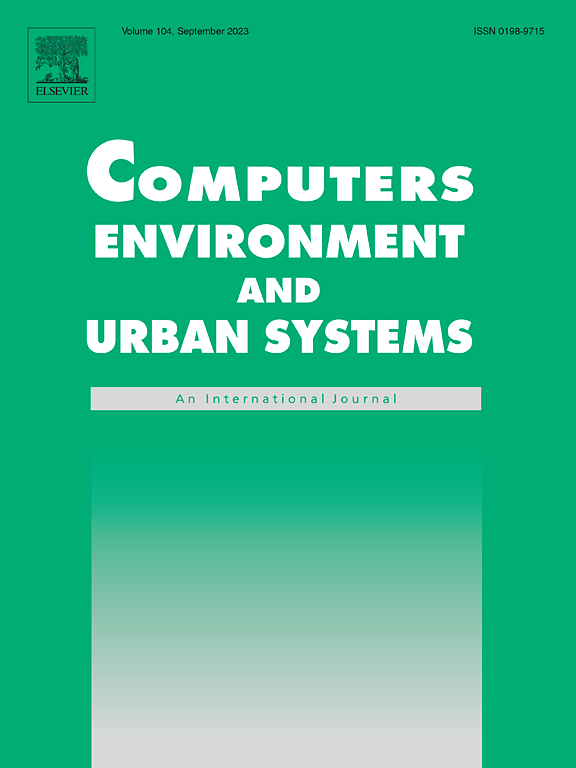绘制上海城市热缓解优先区域:热风险与住房供应
IF 8.3
1区 地球科学
Q1 ENVIRONMENTAL STUDIES
Computers Environment and Urban Systems
Pub Date : 2025-07-26
DOI:10.1016/j.compenvurbsys.2025.102330
引用次数: 0
摘要
全球气候变化加剧了热浪事件,增加了它们的强度、持续时间和频率。室外城市绿地和室内空调空间作为关键的“热庇护所”,为极端高温提供关键的冷却缓解。然而,缺乏对潜在热避难所的空间分布以及不同城市地区的避难所如何匹配不同程度的热风险的研究。为了解决这一研究差距,我们量化并绘制了行政街区(通常是城市治理的最小层面)和500 × 500米(老年人等弱势群体常用的舒适步行距离)的步行网格的热风险和住所供应图,并确定了应优先采取热缓解干预措施的脆弱区域。我们选择了拥有2500万人口的大都市上海作为案例研究对象,上海正在经历越来越多的极端热浪事件。我们通过结合热危害、暴露和脆弱性的综合指数来衡量热风险。我们主要通过室内空调场地和室外绿地的数量来衡量热量供应,并根据它们的可用性进行加权。我们的研究结果揭示了从城市核心到郊区的热缓解优先级普遍下降,这种模式在大都市尺度上在社区和网格之间是一致的。也就是说,在较小的尺度上,这两种类型的空间单元在热缓解优先级的程度和分布上出现了显著差异,揭示了不同城市地区应对极端高温的细微差别和不公平能力。我们的研究为评估热减排优先级提供了一种新颖而系统的视角,为规划和管理热庇护所以及分配热减排资源提供了更有效的策略。本文章由计算机程序翻译,如有差异,请以英文原文为准。
Mapping priority zones for urban heat mitigation in Shanghai: Heat risk vs. shelter provision
Global climate change has intensified heat wave events, raising their intensity, duration, and frequency. Outdoor urban green spaces and indoor air-conditioned spaces serve as critical ‘heat shelters’, providing crucial cooling relief to extreme heat. However, there is a lack of studies focused on the spatial distribution of potential heat shelters and how shelters in different urban areas match varying degrees of heat risk. To address this research gap, we quantify and map heat risks and shelter provisions of administrative neighborhoods (often the smallest level of urban governance) and walkable grids of 500 × 500 m (a commonly-used comfortable walking distance for vulnerable groups such as the elderly people), and identify vulnerable areas where heat mitigation interventions should be prioritized. We select Shanghai – a metropolis of around 25 million people experiencing increasingly extreme heat wave events - for the case study. We measure heat risk by a composite index incorporating heat hazard, exposure and vulnerability. We largely measure heat provision by the number of indoor air-conditioned venues and outdoor green spaces, weighted by their time availability. Our findings reveal a general decrease in heat mitigation priority levels from the urban core to the suburbs, a pattern that is consistent between neighborhoods and grids at the metropolitan scale. This said, at smaller scales, significant differences between these two types of spatial units emerged in the degree and distribution of heat mitigation priority levels, revealing nuanced, inequitable capacities of different urban areas to tackle extreme heat. Our study provides a novel and systematic lens for assessing heat mitigation priority levels, informing more effective strategies for planning and managing heat shelters and allocating heat mitigation resources.
求助全文
通过发布文献求助,成功后即可免费获取论文全文。
去求助
来源期刊

Computers Environment and Urban Systems
Multiple-
CiteScore
13.30
自引率
7.40%
发文量
111
审稿时长
32 days
期刊介绍:
Computers, Environment and Urban Systemsis an interdisciplinary journal publishing cutting-edge and innovative computer-based research on environmental and urban systems, that privileges the geospatial perspective. The journal welcomes original high quality scholarship of a theoretical, applied or technological nature, and provides a stimulating presentation of perspectives, research developments, overviews of important new technologies and uses of major computational, information-based, and visualization innovations. Applied and theoretical contributions demonstrate the scope of computer-based analysis fostering a better understanding of environmental and urban systems, their spatial scope and their dynamics.
 求助内容:
求助内容: 应助结果提醒方式:
应助结果提醒方式:


